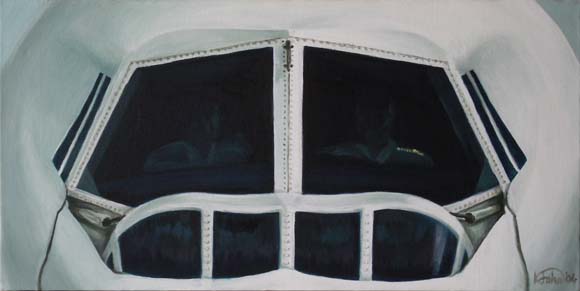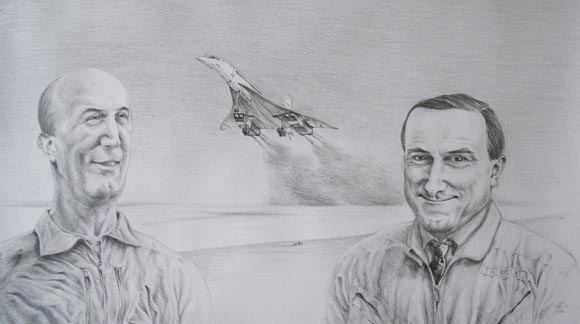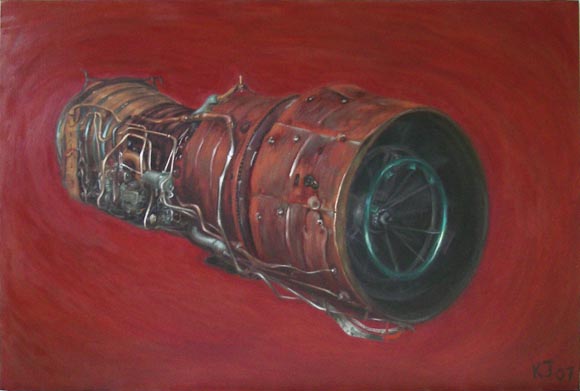9 Early paintings
Here’s looking at you (2004)
Concorde seems more like a living being than a machine. I think this is partly because of the “face”, with its mobile nose and its two front windows like big eyes. (When the nose and visor go down, it always makes me think of a person taking off their glasses to look at you intently.) I wanted to give this sense of Concorde’s “personality” by showing her looking directly at the viewer – as are the pilots, just visible behind the windscreen.
Dream (2004)
Many people, like me, find Concorde beautiful. She has an otherworldly quality. When moving, she is quick and responsive. She changes as you watch, especially when she droops her nose and rises into the air like a great bird. (I compare her to the wise, powerful, protective Simurgh of Persian legend.) Some people find her unsettling, and those who hate the noise and exhaust even see her as sinister. I don’t think this is a bad thing – the beautiful and disturbing elements combine to make Concorde sublime.
Easter 2004 (2006)
From Dream to nightmare – this is my response to what was done to Alpha Alpha. It took me two years to get around to painting this. I had been so shocked by the way Alpha’s wings had been sheared off, and by seeing her mutilated body paraded through the centre of London. (It reminded me of that bit in The Lion, the Witch and the Wardrobe, where Lucy finds Aslan tied to the sacrificial slab, with his mane shorn away.) Standing on Tower Bridge and seeing her slide under our feet felt obscenely wrong. I remember wanting to stow away in the barge, to stay with her. This picture is my imagining of what it must have been like inside there, in the cold and the dark. This marks the absolute nadir of Concorde’s existence – even the British Airways speedmarque is black.
The picture is not for sale. I can’t imagine that anyone would want it.
First flight (2006)
I drew this to commemorate the first ever Concorde flights, and the French and British Chief Test Pilots who performed them in 1969. I saw André Turcat in 2009, in Toulouse, at the event to mark the 40th anniversary of the first French flight. I didn’t meet him in person, but he held everyone enthralled with his wisdom and knowledge of the aircraft. He really was a living legend. Sadly, I never met Brian Trubshaw either, as he died in 2001. I did, however, have a lovely conversation with his widow. She told me that when he was carrying out the test flights with Concorde, she used to wait for him to come in, and award his landings marks out of 10 – she must have been the only person on the planet who would dare!
The aircraft shown is one of the prototypes, but I haven’t said which one – it’s up to the viewer to decide.
Un souvenir de l’avenir / A memory of the future (2007)
The title of this painting expresses my feeling that something has gone out of joint with the world – technology has gone backwards. When the Concordes were retired, I would have loved to see them have an active afterlife as scientific and cultural ambassadors for UNESCO – evidence of a stunning technological advance that was made in the cause of peace, and which brought joy and beauty to people around the world.
Olympus 593 (2007)
The Olympus engines on display at East Fortune and Brooklands, and the one at Sinsheim (a project for another day) inspired this painting as they seem to me like gigantic hearts, ready to blast out energy and bring Concorde to life. I am very grateful for the help I received from Gordon Roxburgh’s team at Brooklands, and from Concorde engineer Ian Mosdell, in explaining the structure and checking the details for me as I was researching for this painting.






